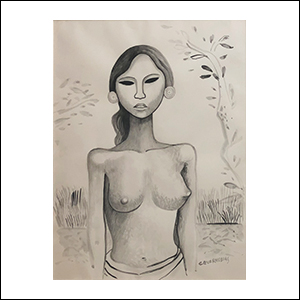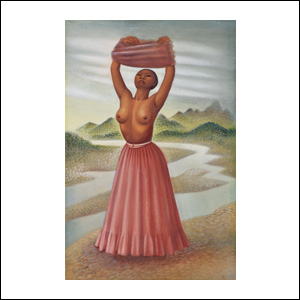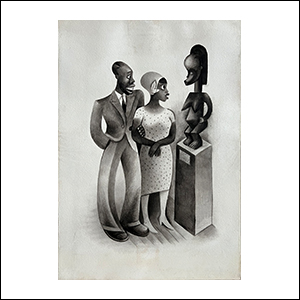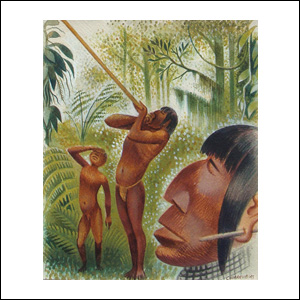Miguel Covarrubias
Mexico City, 1904 - Mexico City, 1957
Miguel Covarrubias - BIOGRAPHY
Miguel Covarrubias was born on November 22, 1904 in Mexico City. He was a great painter, caricaturist, illustrator, writer, anthropologist, archeologist, museologist, collector, stage and costume designer, and dance director. He was what can justly be called a humanist, sincerely and passionately devoted to the study of culture, not only from Mexico, but also from other latitudes, such as: the United States, Central and South America, China, Bali, and North Africa.
Miguel Covarrubias was the first child of Elena Duclaud, whose parents of French and Spanish origin lived in Mexico, and Jose Covarrubias Acosta, whose parents were from Jalapa, Veracruz. At the age of fourteen he finished his formal education. Covarrubias was born with an innate aptitude for drawing and caricature. One of his earliest cartoons is from when he was only 10 years old, a self-portrait of a toothy boy with his pants down around his ankles sitting on a potty chair. He liked to make quick cartoons of himself. His first job was as a draftsman of maps in the communications department of the Mexican government, where he became friends with the painter Antonio Ruiz "El Corcito". Miguel spent his time doing caricatures of his bosses.
He discovered his love for theater since he was still studying. One of his favorite theaters was Teatro Lírico. He attended rehearsals and made friends with actors, comedians, singers, dancers and famous people. He liked the theater so much that he took a job as usher and that way he didn't miss any of the performances. During intermissions, he used to make quick sketches of the viewers, which later used for making cartoons. When he was not in the theater, he was found in the cafe “Los Monotes”, which belonged to Jose Clemente Orozco's brother; the walls were covered with drawings and caricatures of Orozco. Intellectuals, writers and artists met in this cafe. On any afternoon you could find personalities such as Jose Clemente Orozco, Diego Rivera, Manuel Rodriguez Lozano, Abraham Angel, Rufino Tamayo, Jorge Juan Crespo de la Serna, Lupe Marin, Manuel Maples Arce, Jose Juan Tablada, among others. Miguel Covarrubias spent every night in "Los Monotes" meeting people and making caricatures of them, everyone identified him as the kid and gave him the nickname "El Chamaco", because he was much younger than them. There he met Diego Rivera with whom he took some lessons at that time.
The first publication of one of his cartoons was in 1920 on the cover of Policromías, the student magazine of the National University of Mexico. In December of that year, the weekly magazine Zig Zag included a drawing that he had made of the painter Roberto Montenegro. The next edition featured a series of caricatures of spectators attending the opening of a Montenegro exhibition. In 1922, El Heraldo published some satirical interpretations made by Covarrubias of Mexican politicians. Later, his drawings began to appear in the editions of La Falange, his most notorious drawings in this magazine were the portraits he made of Diego Rivera and Manuel Rodriguez Lozano that appeared in the editions of January and July, 1923. Later his cartoons began to appear in other magazines and newspapers.
In the early 1920s Miguel Covarrubias became friends with the painter Adolfo Best Maugard, who in 1921 was selected by Jose Vasconcelos to promote and expand the schools of plein air painting in Mexico. Miguel Covarrubias joined the group of volunteer painters to teach at these schools, along with Antonio Ruiz "El Corcito", Abraham Angel and Rufino Tamayo, among others. At that time, Miguel began to develop an interest in collecting antiques, folk art, colonial objects, and finally pre-Hispanic art.
In 1923, the poet Jose Juan Tablada managed to get the Mexican government to grant Covarrubias a ticket to New York and sustenance for six months. When Covarrubias arrived in New York, Tablada introduced him with Sherrill Schell, a well-known photography artist and writer who had a special interest in Mexico. She assumed the role of agent and introduced Miguel Covarrubias with other personalities, including New York Times music critic Carl Van Vechten, who also advocated for art and artists. Van Vechten arranged for Covarrubias to meet H.L. Mencken, Waldo Frank, Avery Hopwood, Eva Le Gallienne, among others, and also introduced him to cartoonist Ralph Barton, who along with William Cotton and John Held Jr, were the three most popular cartoonists at the time in New York. As soon as Covarrubias started drawing some local faces, it was enough to show his ability and get hired. His first drawings were sold to magazines such as Shadowland, Screenland, Modes and Manners, Current Opinion, Nation, and newspapers such as World, New York Tribune, Herald, Evening Post, New York Evening, Telegram Brooklyn Daily Eagle, and Los Angeles Daily Times.
His work caught the attention of Frank Crowninshield, editor of Vanity Fair magazine, who invited him to collaborate with the magazine. His first works in Vanity Fair appeared in January, 1924. They were several portraits of celebrities, including a caricature of the cartoonist Ralph Barton, who in turn also made a caricature of Covarrubias that appeared in the same publication. In the following publications, Covarrubias did caricatures of politicians, theater artists, and intellectuals. In March 1924, Covarrubias presented his first exhibition at the Whitney Studio Club, with the original cartoons that had appeared at Vanity Fair.
Miguel Covarrubias shared an apartment in New York with Adolfo Best Maugard on Beale Street. Thanks to Best Maugard, Covarrubias met the dancer Rosemonde Cowan, who later adopted the name Rosa Rolanda and would become Covarrubias' wife.
Covarrubias liked to visit Harlem nightclubs, the place where black culture flourished around jazz, blues, dance, and spiritual songs. Of those visits, Covarrubias made his series of drawings known as Negro Drawings. Vanity Fair issue of December 1924 published eight of his drawings of blacks from Harlem. These were the first African American drawings published by Vanity Fair.
From 1925 Covarrubias began to collaborate also with The New Yorker, and to illustrate books, such as: The New Negro with three of his drawings; the cover of the book The Weary Blues; and illustrations from the book Blues by W.C. Handy. He also published his first book, The Prince of Wales and Other Famous Americans, with 66 cartoons that included politicians, writers, artists, musicians, and athletes.
In summer of 1926, Miguel Covarrubias took Rosa Rolanda to Mexico to meet his family and friends. From there they traveled to Cuba, where Covarrubias made several drawings, some of which appeared in Vanity Fair. Then they went to Paris where Covarrubias did the cartoon series This is Really Paris: Its Types, Terrors and Temptations. They lived in Paris what was left of 1926 and all of 1927 at the Hotel Excelsior. There Rosa Rolanda also began to paint. Some of Covarrubias' drawings were published in 1927 and 1929 at Vanity Fair. In 1927 his book Negro Drawings was published. At the end of that year, Miguel and Rosa traveled to North Africa where Miguel made drawings of black indigenous people, which he also sent to Vanity Fair from Morocco, Algeria, Tunisia, Tripoli (Libya), and other points. His fascination with black people continued, as well as ethnic art. Wherever he traveled, he collected local art, masks, costumes, figures, toys, ceramics, and jewelry.
In February 1928, Vanity Fair published some of his drawings of Africa, this publication coincided with an exhibition that Covarrubias presented at the Valentine Gallery. At the end of that year Jose Juan Tablada published his book of poems, La Feria, with illustrations by Matias Santoyo, George “Pop” Hart, and 16 illustrations with Mexican themes by Miguel Covarrubias. The next year Covarrubias collaborated with illustrations for another Tablada’s book, La Babilonia de Hierro. In the summer of 1928, Miguel and Rosa traveled to Mexico with the idea of studying the ethnography of Mexico. They spent a lot of time with Diego Rivera and Frida Kahlo, they also met Andres Henestrosa and Fernando Gamboa. Back in New York, Covarrubias illustrated the book Meaning No Offense by John Riddell, Adventures of an African Slaver by Theodore Canot, and Born to Be by Taylor Gordon.
Miguel Covarrubias and Rosa Rolanda were married in New York on April 24, 1930. On a honeymoon they traveled for a long time to Bali, traveled by boat and stopped at Yokohama, Tokyo, Kobe, Shanghai, Hong Kong, Manila, Madagascar, Java and finally Bali. Miguel and Rosa were fascinated by the Balinese lifestyle, they delved into their culture, dance, music, costumes, rituals, ceremonies, customs, beliefs, religion, villas, temples, festivals, activities, food, art, masks. Everything was captured by Covarrubias in his paintings and drawings, at the same time that Rosa did it through photography. Of the nine months they were in Bali, there was one month in which Miguel traveled and stayed in Shanghai, China. He was interested in all aspects of Chinese culture, art, politics, society, language and even its writing. Twenty-eight of his drawings from China served to illustrate the book China by Marc Chadourne.
In January 1932 the Valentine Gallery in New York presented 32 works among oils and gouaches from Covarrubias stay in Bali. The exhibition was a success and generated a lot of interest from critics. From that moment on, he began to exhibit his works with great regularity. In that year he illustrated René Maran's novel Batouala about French colonialism in Africa.
In 1933, Vanity Fair published Miguel Covarrubias' first work of his well-known series “Impossible Interviews”, each drawing portraying two well-known personalities in a fictional and unlikely conversation. The first “Impossible duo” was Mahatma Gandhi in conversation with evangelist Aimee Semple McPhearson. He also began contributing drawings for Vogue magazine, and made his second mural for the home of his friends John and Alice Warder Garrett; his first mural “Celestial Bodies" had been featured in his 1928 exhibition at the Valentine Gallery.
Covarrubias won the Guggenheim Scholarship for the paintings he made of the Dutch Indies (Indonesia), which provided him with the resources for a second one-year trip to Bali from 1933 to 1934. Before returning to New York, they visited China again, stopping in Hong Kong, Canton, and finally Shanghai where they stayed for a month at the home of their friends Bernadine and Chester Fritz. They visited Soochow and Peking. It took 58 days for them to return to New York by ship. During the returning trip Covarrubias painted six paintings and wrote the first three chapters of his book Island of Bali.
During 1935 and 1936, Covarrubias continued to paint and devotedly worked on his book Island of Bali. His works from Bali appeared in magazines, museums, and exhibitions. The Brooklyn Museum exhibited his painting Balinese Dancers in the exhibition “The Dance in Art” in 1936. His book Island of Bali was finally published in mid-November, 1937. It was a best-seller even before appearing in bookstores, and was considered a true scientific work of great contribution to the knowledge of the Balinese culture.
In early 1935, two of his works were exhibited at the Carnegie International Exhibition of Modern Painting in Pittsburgh, Pennsylvania, representing Mexico along with works by Jose Clemente Orozco, Siqueiros, and Carlos Merida. One of them was his famous painting The Bone, and the other a gouache titled Rio Tehuantepec that was purchased by the Carnegie Institute. In March of that year, he participated in the inaugural exhibition of Galeria de Arte Mexicano in Mexico City, along with works by Diego Rivera, Frida Kahlo, Jose Clemente Orozco, Siqueiros, Roberto Montenegro, Carlos Merida, Maria Izquierdo, and other important artists. In late 1935, Miguel and Rosa Covarrubias moved to Mexico.
He illustrated some editions of books such as Typee by Herman Melville, Mules and Men by Zora Neale Hurston, Green Mansions by William H. Hudson, Uncle Tom's Cabin by Harriet Beecher Stowe, The Discovery and Conquest of Mexico by Bernal Diaz del Castillo, All Men Are Brothers by Shih Nai-an, Los Aztecas Pueblo del Sol by Alfonso Caso, among others. He made six wall maps of the Pacific Rim for the Golden Gate International Exposition. He traveled many times to the Isthmus of Tehuantepec to collect material for his book Mexico South. He collaborated in organizing the Twenty Centuries of Mexican Art exhibition at the Museum of Modern Art in New York in 1940. He received another grant from the Guggenheim Foundation to cover his research for his book Mexico South: The Isthmus of Tehuantepec, which after years of research finally was published in 1946.
His interest in collecting pre-Hispanic art as well as art from the cultures he met on his travels around the world, led him to delve into his research and expand his knowledge on the subject. During his explorations in Mexico, he made hundreds of drawings of pre-Hispanic figures that he used for classification and study. He was the director of the excavation project of the Institute of Anthropology in Tlatilco area. In 1943, he helped integrate the study programs of the School of Anthropology and the School of History, where he also taught courses in Pre-Hispanic Art, Primitive Art, Art History, and Anthropology. He carried out different essays on his research, including: Olmec or La Venta art, The Political Roots of the Art of Tenochtitlan, Tlatilco: Preclassic Art and the Culture of the Valley of Mexico, Topology of the Industry of Stone Carving and Polishing of the Mezcala River Valley, among others.
In 1941, Covarrubias assisted René d’Harnoncourt in organizing an exhibition in New York on North American Indian art, which sparked his interest in investigating this art thoroughly and making a book on the subject. He asked the Guggenheim Foundation for help to cover his research and got the resources, which allowed him to travel for two months visiting collections in museums and universities in the United States, Canada and Alaska. In 1945, Covarrubias and René d’Harnoncourt also organized the exhibition The Indigenous Art of North America at the Museo Nacional de Antropología in Mexico City. His book was published in 1954 under the title The Eagle, the Jaguar, and the Serpent.
Covarrubias assisted René d’Harnoncourt in assembling and installing the Arts of the South Seas exhibit at the Museum of Modern Art in New York in 1946, and illustrated the catalog for the exhibit. In 1947, he made two murals at the Hotel El Prado in Mexico City, which were destroyed in the 1985 earthquake. He also did the mural One Afternoon in Xochimilco at the Ritz Hotel, in Mexico City. At the end of that year, Miguel Covarrubias managed to get Nelson Rockefeller to give the initial funds for a three-year exploration program in Palenque, with the condition that the Institute of Anthropology and the Government of Chiapas finance the rest. Covarrubias participated together with Alfonso Caso and Alberto Ruz in said project.
In 1950, Carlos Chavez, director of the Palacio Nacional de Bellas Artes (National Palace of Fine Arts), created the Dance Academy and appointed Miguel Covarrubias as artistic director. In the two years he held that position, he brought great prosperity and development to dance in Mexico. At the academy he met the dancer Rocio Sagaon with whom he married in a simple religious ceremony in 1955, without having legally divorced Rosa Rolanda. This decision caused him many problems for the rest of his life.
Miguel Covarrubias died on February 5, 1957 in Mexico City. That same year after his death his book Indian Art of Mexico and Central America was published.
(Source: Covarrubias, por Adriana Williams, University of Texas Press, Austin, 1994)
Main Solo Exhibitions
|
1924 Vanity Fair, original drawings, Whitney Studio Club, New York |
|
1925 Harlem drawings, "American Watercolors", The New Gallery, New York |
|
1925 Miguel Covarrubias: Caricatures, The Dudensing Gallery, New York |
|
1928 Valentine Gallery, New York |
|
1932 Balinese Paintings, Valentine Gallery, New York |
|
1936 Exhibited 15 gouaches ofImpossible Interviews series and 12 of Batouala, Fifteenth International Exhibition of Watercolors, Art Institute of Chicago |
|
1939 Exhibited at the "Golden Gate International Exposition" of San Francisco six ethnographic atlases, that thoroughly describe the people, economy, art, flora and fauna, housing and communications of the Pacific |
|
1944 Exhibited various artworks in the show El Arte Mexicano de Hoy, Philadelphia Museum |
|
1957 Galería Antonio Souza, Mexico City |
|
1981 Galería de la Universidad Autónoma de México, Mexico City |
|
1987 Homenaje a Miguel Covarrubias, Centro Cultural Arte Contemporáneo, Mexico City |
|
2004 Museo Soumaya, Plaza Cuicuilco, Mexico City |
|
2004 Geografía de un Ilustrador, Museo Mural Diego Rivera, Mexico City |
|
2004 El Chamaco y otros Mexicanos Famosos, Museo Casa Estudio Diego Rivera y Frida Kahlo, Mexico City |
|
2004 Yólotl Bali, Yólotl Tehuantepec, Museo Casa Estudio Diego Rivera y Frida Kahlo, Mexico City |




